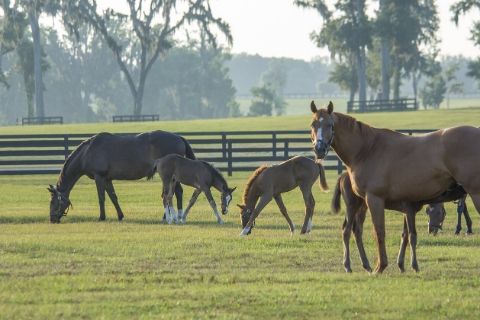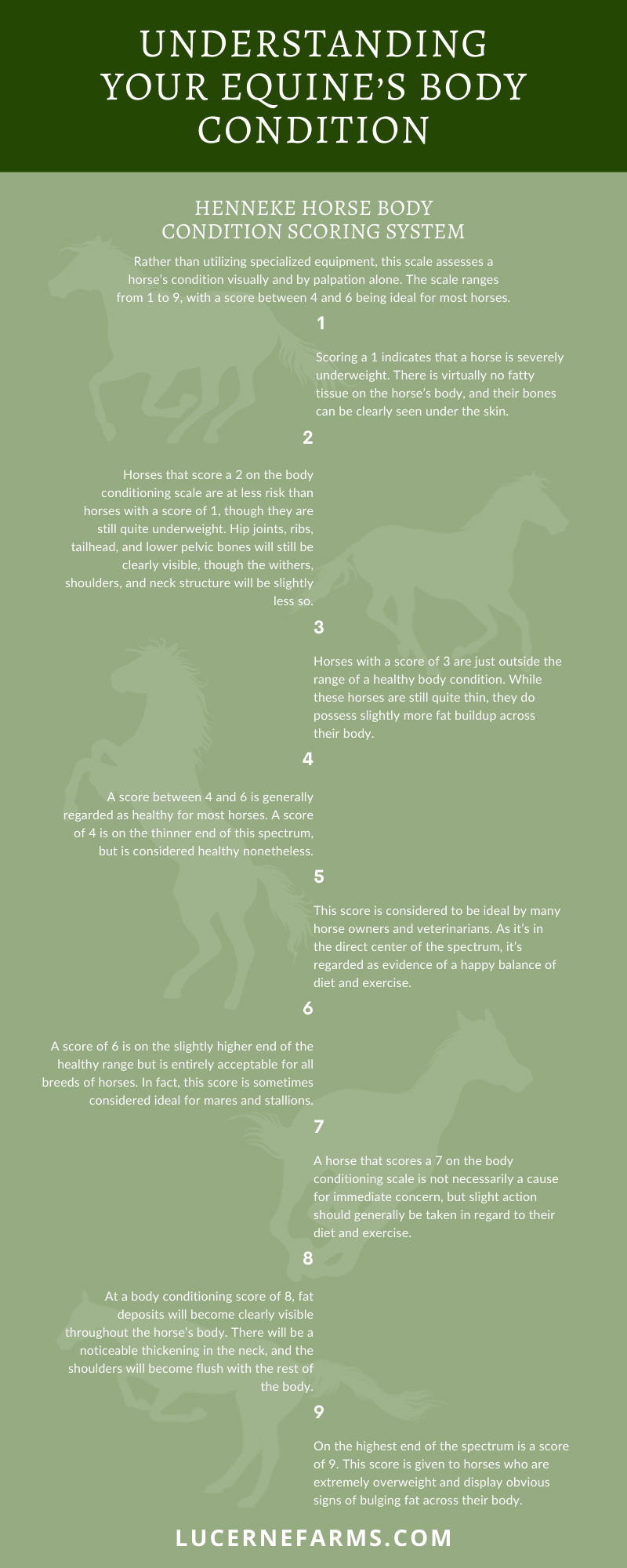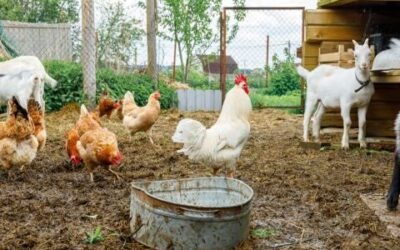
Just like humans and snowflakes, no two horses will ever look exactly the same. A horse’s physical appearance can depend on many different variables, including breed, diet, and exercise. Because every equine is beautiful in its own unique way, it can sometimes be hard to know if your horse is on the right track to its healthiest form. A Clydesdale and a Quarter Horse will look vastly different from each other, after all, even if both are in peak physical form. However, regardless of breed, there are a few methods to ascertain the physical condition of your horse. One popular method is the Henneke Horse Body Condition Scoring System. This brief guide will help you further understand your equine’s body condition as it pertains to this specific scoring system.
Henneke Horse Body Condition Scoring System
The Henneke Horse Body Condition Scoring System was first put into place in the early 1980s at Texas A&M University. The system was devised with the intent of serving as a universal scale to assess a horse’s body condition. This system differed from other systems in that it didn’t require additional equipment and could be used across all horse breeds. Rather than utilizing specialized equipment, this scale assesses a horse’s condition visually and by palpation alone. The scale ranges from 1 to 9, with a score between 4 and 6 being ideal for most horses. The ideal score for a given horse may vary depending on the horse itself. Below is a more comprehensive breakdown of each score in the Henneke Horse Body Condition Scoring System.
1
A horse that scores on either extreme end of the Henneke Horse Body Condition Scoring System is cause for concern. Scoring a 1 indicates that a horse is severely underweight. There is virtually no fatty tissue on the horse’s body, and their bones can be clearly seen under the skin. Horses in such a condition will require special care and feed in order to return them to a healthy weight. Begin by establishing a feeding schedule and making gradual changes to their diet. Increasing their feed drastically and going too fast, too soon, can often cause more harm than good. Introducing chopped hay for horses into their diet is a good way to start them on a more regular feeding schedule while also ensuring they receive their necessary daily nutrients. Chopped forage is rich in fiber and naturally occurring vitamins and minerals, which are often lacking in horses at a body condition score of 1.
2
Horses that score a 2 on the body conditioning scale are at less risk than horses with a score of 1, though they are still quite underweight. Hip joints, ribs, tailhead, and lower pelvic bones will still be clearly visible, though the withers, shoulders, and neck structure will be slightly less so. The transverse processes of the lumbar vertebrae may also feel rounded. Such horses are still considered emaciated and should adhere to roughly the same feeding schedule as a horse with a score of 1.
3
Horses with a score of 3 are just outside the range of a healthy body condition. While these horses are still quite thin, they do possess slightly more fat buildup across their body. This fat buildup is most easily discernible on the ribs and spinous processes. The transverse processes can no longer be felt, though the tailhead may still be noticeable. The most important distinction between a score of 2 and a score of 3 is that though the tailhead may still be noticeable, it is much more difficult to identify individual vertebrae.
4
A score between 4 and 6 is generally regarded as healthy for most horses. A score of 4 is on the thinner end of this spectrum, but is considered healthy nonetheless. Horses that score accordingly may display a slight ridge along their spine and ribs may be slightly visible but fat buildup can be easily detected throughout.
5
This score is considered to be ideal by many horse owners and veterinarians. As it’s in the direct center of the spectrum, it’s regarded as evidence of a happy balance of diet and exercise. Horses with this score have a flat back and slight fat around the tailhead. While the ribs are not clearly visible for horses of this score, they can still be easily felt when palpated. The neck blends smoothly into the shoulders, which blend smoothly into a level back and firm body.
6
A score of 6 is on the slightly higher end of the healthy range but is entirely acceptable for all breeds of horses. In fact, this score is sometimes considered ideal for mares and stallions. Such horses have a significantly higher energy output, and maintaining a slightly higher body condition score generally yields higher reproductive success. Horses with this score begin to feel slightly fleshy throughout the ribs, tailhead, shoulders, and neck.
7
A horse that scores a 7 on the body conditioning scale is not necessarily a cause for immediate concern, but slight action should generally be taken in regard to their diet and exercise. Fat deposits can be clearly felt throughout the neck, shoulders, ribs, and tailhead, though the ribs can still be felt when palpated. Increasing the amount of exercise your horse receives on a daily basis will generally be sufficient to keep your horse from becoming overweight.
8
At a body conditioning score of 8, fat deposits will become clearly visible throughout the horse’s body. There will be a noticeable thickening in the neck, and the shoulders will become flush with the rest of the body. The ribs will be difficult to feel, and there will be a clearly visible positive crease down the back. Caring for an overweight horse presents equally as many challenges as caring for an underweight equine. Reducing access to pasture will help cut some calories from your horse’s diet and adjusting their diet to feature less fatty feed will allow you more control over their daily calorie and nutritional intake. It will also be in your best interest to increase the amount of exercise the horse regularly receives. Turning out your horse more often is a good option, but some horses will simply stand around waiting to be fed again. Establish an exercise routine instead. Even if you and your four-legged friend only embark on a short ride every other day, they will still be receiving more exercise than they likely had been. As an added bonus, you’ll get to spend more time with your equine BFF and get to indulge in a bit of fresh air and exercise yourself.
9
On the highest end of the spectrum is a score of 9. This score is given to horses who are extremely overweight and display obvious signs of bulging fat across their body. Horses that receive this score will likely require drastic changes to their diet and exercise routine. Be sure to consult your veterinarian before making major changes, however. Your vet will be able to offer the best advice regarding diet and exercise as it pertains to your horse’s individual health needs.





